I’m happy to welcome my media naranja, Adriana Camarena, as a guest blogger. This is her first but I hope not last contribution to The Nowtopian!
When I think of bicycles in Mexico beautiful images of workers spring to mind. Delivery men flutter on the streets on two or three wheels pollinating the neighborhoods with water, bread, telegrams, mail, newspapers, flowers, pharmacy errands, tacos de canasta, and other daily comforts. The factory workers also arrive on their bicycles. The films of the Golden Age of Mexican Cinema — often in the same category as cult Mexican films — nurtured the national imagination with an abundance of characters on bicycle. Pedro Infante -““ a legendary Mexican singer and actor of that era — in a biographical film about his life is depicted as a humble bicycle mechanic in his beginnings. Among my favorite cast of characters on bicycle is the knife sharpener. He blows a sharp whistle as he rides through the street, telling his clients that he is available. When I lived in Mexico City, many times I called out from my top window “I’ll be right out!” El Afilador de Cuchillos places his back wheel on a stand. He sits and peddles backwards on his bike to whirl the sharpening stone; sparks fly to give knives a new edge. For more than a century, such workers have peddled the streets of Mexico. Even in the most populated cities of Mexico, the flowers, the bread, the water, the news, the mail, still arrive on bicycle.
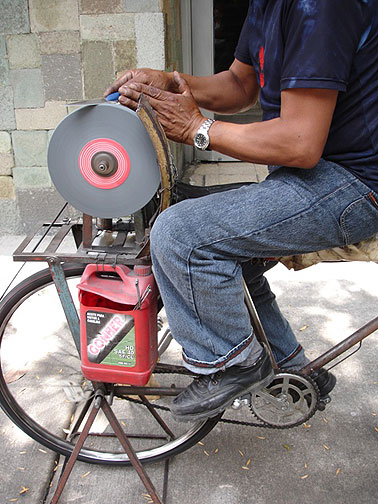
Knife sharpening on the streets of Mexico with a bicycle-based machine.
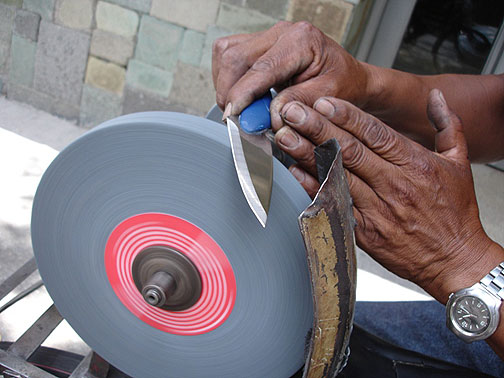
On Saturday, September 19th 2009, Chris and I wandered the pedestrian zones of the historical colonial center of Guadalajara during the lunch hour, here known as la hora de la comida or la hora de la siesta. La hora lasts about two hours. We spent the hour eating pistachio and prune ice paletas, while window shopping, buying a wooden spatula on the street, and people watching; I even tried on a sparkly Quinceañera crown made of silver and crystals because it was rather remarkable. In other words, we were making time before the afternoon conferences of the second day of the Second Annual National Cycling Conference. (I say making time, because while English speakers “kill time” whenever they have a surplus of time on their hand before an event, we Spanish speakers say we are haciendo tiempo: making time.)
While we wander around, making time, I see an elder gentleman with his bicycle in front of a pharmacy. I shamelessly ask him “Disculpe, señor, are you a messenger?” Messengers are on my mind. Later that afternoon, we will attend a conference delivered by a panel of bike messengers.
Well, this is my own purchase, right now”, he says pointing to a bag in the crate on the back of his bike, “But, I am a messenger in everyday life. “¦ Once upon a time, I delivered telegrams.”
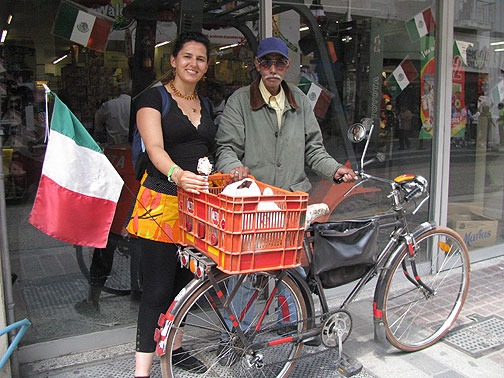
Adriana and Don Francisco Gonzalez Estrada with his 1957 bicycle.
We have a conversation, and part ways. Chris and I retrace our steps to the Museo de la Ciudad to attend the Bicycle Messenger Talk headed by bike messenger Jimmy Lazima from Los Angeles, California, one young bike messenger from Ciudad Guzman, Jalisco, and fixie bike aficionados from Guadalajara. Jimmy engages the audience with stories about riding and working through gridlocked Los Angeles streets. The Mexican messenger talks about his on-going and painstaking efforts to set-up business, create a clientele basis, and promote ecological culture in Ciudad Guzman without yet being able to make a living from his efforts.
The messenger presentation is followed with a promotional video of fixie riders careening through San Francisco without breaks or gear shifts, and a talk about the Alley Cat bike messenger races and comparable rally races in Mexico. These collective experiences infuse me with a wanton desire for the adrenaline and glamour of outlaw bicyclist. Yet, I wonder about the bike messengers delivering to the conference. I venture to describe these bicycle messengers as blue-collar-urban-guerrillas opting out of a life in an office cubicle for a life of daily delivery rally races. They represent a new generation of bicycle workers, who are most visible due to their extreme physical dexterity, wit, and environmental commitment. They are workers responding to a frenetic labor and car-choked city environment. Without a doubt, they make bicycling sexy and this attraction is fundamental towards creating new city cyclists, but I wonder, how novel are bike messengers in a country such as Mexico with a long tradition of bicycle workers?
I won’t argue against importing the benefits of a new bicycle messenger culture into Mexico. After all, as mentioned, this new culture is an adaptation to current city conditions in many places. Furthermore, the conference organizers represented by a handful of educated college Mexican students, have busted their asses to bring people together from across the country and the world to share a diversity of experiences of environmental activists and new urbanists across the planet. So, I shift towards wondering about the former generation of bike messengers. How do we connect a cult classic generation of Mexican bicycle workers to this new sexy generation of bike messengers? How do we honor and recover Mexico’s self-definition as a bicycling nation while adapting to the flux of thoughtful and provocative environmental politics coming in from the outside?
Before the presentation ends, I feel a tap on my shoulder. I smile, and lean over enthusiastically to shake the hand of Don Francisco Gonzalez Estrada; the older gentleman who I had met earlier, and who I invited to the bike messenger conference. He knew where to find the museum without an address, he found the panel on the second floor, found me, and found a seat. The Q&A portion of the talk begins. He leans over, “Do you think my bike will be alright outside? There is a young man watching over the bikes. He said he would watch over my bike. I put a chain on it anyways.”
“Yes, I think it will be ok.”
There are questions about helmets. Don Francisco leans over again. “I have a helmet also. I rarely use it. It’s more like an aviator helmet, like the one Cantinflas used.”
I nod, and I am trying to catch the eye of the moderator. He passes me over for the last question, but I insist. The talk is running late, and the moderator does not want to allow me to take a final question, but I insist, and the room supports my petition.
“I am not here to ask a question. I want to tell a story.” I get booed. I smile and insist, “This is important. I want to introduce Don Francisco Gonzalez Estrada born in 1943 in the Colonia Del Santuario of Guadalajara. He bought his bicycle on April 15, 1957, the same day Pedro Infante lost his life in an aviation accident. He has been a bicycle messenger since then. I thought I would introduce the new generation of bicyclist messengers to the former generation.”
I pass the microphone to Don Francisco, and a roar of applause breaks out from the room. The panelists are clapping. People with cameras approach Don Francisco. He is surrounded by bicyclist paparazzi. Flash. Flash. Flash. The young Mexicans approach him as if he was Pedro Infante himself (who by the way was known to Don Francisco, amongst other celebrities). He speaks with grace, clarity, and firmness.
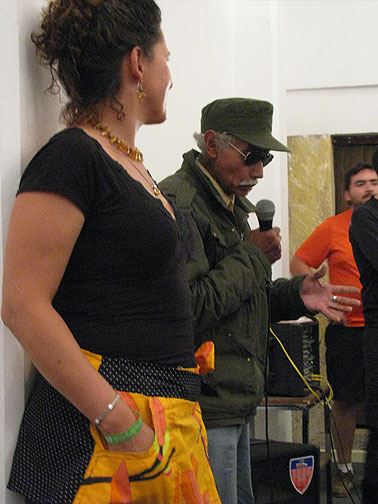
Don Francisco regales the Cycling Congress, Sept. 19, 2009.
“I bought my first Turismo bicycle in 1957. Before the 1980’s, people respected cyclists on the roads of Guadalajara. Our bicycles had license plates, and we had to carry registration papers. We had to have a front light, and red back light. We were treated like another vehicle on the road by city regulations. “¦ I always take my extreme right on every road; even when I cycle against traffic. If I see someone hurtling towards me, I step off the road, on to the sidewalk. I have never had an accident.”
Don Francisco’s presentation is brief. The crowd breaks into an uproarious applause again. The panel talk concludes. Young Mexicans come up to take his picture but can’t seem to find the words to speak to him. Here is an Icon. They admire him from afar. They do not know how to talk to him. This is not only a generational gap, but a class gap. Even so, his generation of bicycle workers has been reinserted into the discussion, and our imaginations, if but for a fleeting minute.
Afterwards, he shows me an old photograph of himself; a handsome 30-year-old to his handsome 66-year-old face. He is engaged; connected; and at the moment, acknowledged. Outside on the sidewalk we keep talking. He tells me he uses the new bicycle path on Federalismo to come to and fro on certain work routes, and hopes that good efforts will be made to respect the path, for fear that it will be invaded by other uses. Don Francisco hopes that a more substantial bicycle path is also placed on Chapultepec Avenue to provide a safer route than just a painted line on the street, which is not respected by motorists. He shows me his sound and light systems on his bicycle to be seen in traffic.
A woman takes photos of him, and I ask her to take his information in order to deliver a copy to him. She agrees. A conference organizer–El Negro–jots down Don Francisco’s work address, promising to pass by and provide him with information about bike rides and other bike activism. I hope they follow up. There is a natural momentum in creating contact between the old generation and the new generation of cyclists. How many people knew, before Don Francisco came along and spoke, that Guadalajara was a bicycle friendly city, where cyclists were treated fairly on the roads? There is much to be learned and recovered from past and present generations of Mexican workers on bicycles by young generations of environmental activists. I don’t believe in gaps. The entire urban cycling movement depends on making the invisible visible; quiet literally on making cyclists visible to motorists. I invite new generations of cyclists in Mexico to make an effort to see the old generation of cyclists: our icons.
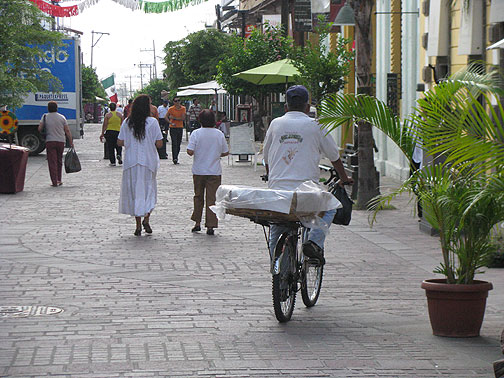
Bread delivery by bike in Tlaquepaque, Guadalajara.
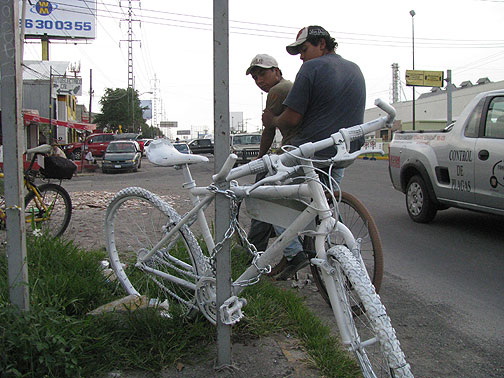
Two workers going home on bike pass a just-installed Ghost Bike.

Since our friends in Guadalajara started installing "ghost bikes" to commemorate killed cyclists, they've already had to put up 5, and it's only been a little over a month!












I loved this post. I was born in Mexico City and grew up buying tortillas from the guy who rode by the street in his bicycle, blowing his whistle. Definitely different to the Afilador.
I think you should edit your post and correct “peddling” to “pedaling”, but that’s just my unsolicited opinion. 🙂